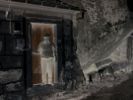Eye For Film >> Movies >> Night Without Distance (2015) Film Review
Night Without Distance
Reviewed by: Rebecca Naughten

Following on from his feature debut - Coast Of Death (2013) - director Lois Patiño returns to the short form for a further examination of landscapes and folk histories in his home region of Galicia. Set on the borderlands between Galicia and Portugal, Night Without Distance (Noite Sem Distância) is ostensibly about the smuggling of contraband across the border - a practice that has gone on for centuries - and takes place over the course of one night as various people wait, hidden in the landscape, for the required signal to move.
Rather than an action narrative, this is a film of silences and pauses, hushed conversations and isolated contemplation. A network of people is scattered across the landscape and along a river at the foot of the Gerês Mountains while they wait for sign of expected parties from across the border. The wind rustling the trees is the predominant sound. Nervous conversations take place - people are worried about informants and the authorities catching them - but for the most part they stand silently, looking out into the darkness.

Ordinarily, a film set at night in the middle of nowhere would come up against the visual problem of the audience being unable to distinguish what was going on in the dark. However Patiño flips the image into a colour negative, meaning that not only are the isolated figures visible to us but the entire enterprise gains a phantasmal filter, and human figures (and dogs and sheep) are rendered ghost-like in this X-Ray vision. It also makes what should be the most hidden objects, the most visible - not only do we see the figures in the landscape, but the bags of contraband almost glow from the (bright white) darkness at the mouth of the cave where they are stashed.
This visual inversion also has the effect of flattening or foreshortening the perspective - the relative space between objects is often only readable through the hues in which they appear (different colours seem to suggest different planes within the frame). Through the combination of this and the colour tones (greens, blues and purples, with an additional patina of dull bronze in those locations with more reflected light), the visuals also call to mind cave paintings - renderings of historical tales come to life.
There is a sense of historical continuation both through the awaited activities and the way in which the darkness draws a veil of timelessness over the landscape. But this is also pointed to in quotation at the start of the film, which ends with the line "There are trails of souls in landscape...". This line flashes up twice and finds a visualisation in the final, startling image of the film where the rocky landscape suddenly comes to life - bringing to mind the “Fear not, till Birnam wood. Do come to Dunsinane” line from Macbeth, but with rocks rather than trees - as the sheer number of souls in the landscape is finally revealed.
Night Without Distance is in many ways a continuation of the issues explored by Patiño in Coast Of Death - and evidence of an ongoing fascination with landscapes, as also seen in his other shorts - but here he is experimenting with the image in a different manner. What could be a gimmick in other hands instead confers a layer of unreality and eeriness onto the exploration of the landscape while also supporting the interpretation of an historical repetition of events through the ghostly strangeness of the effect.
Reviewed on: 11 Oct 2015
















